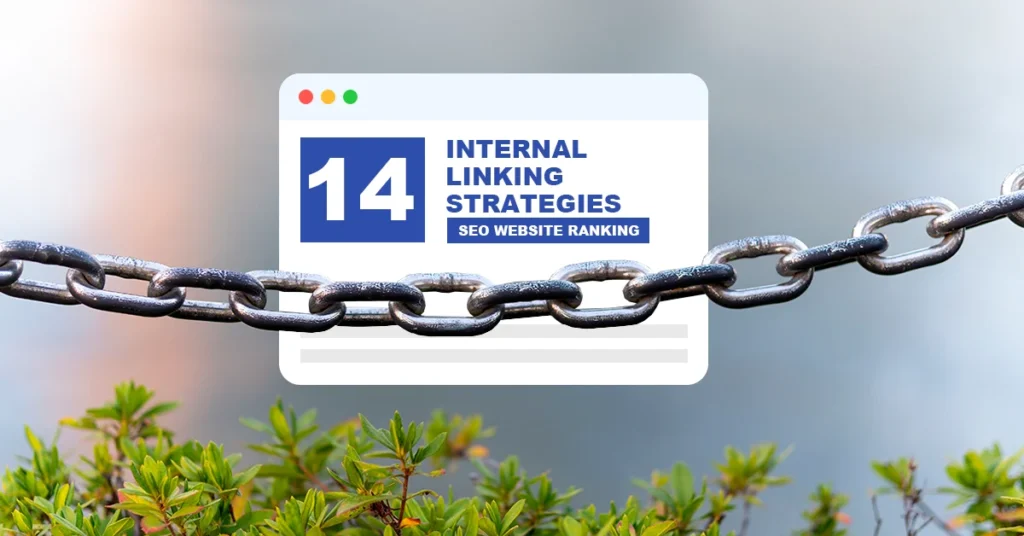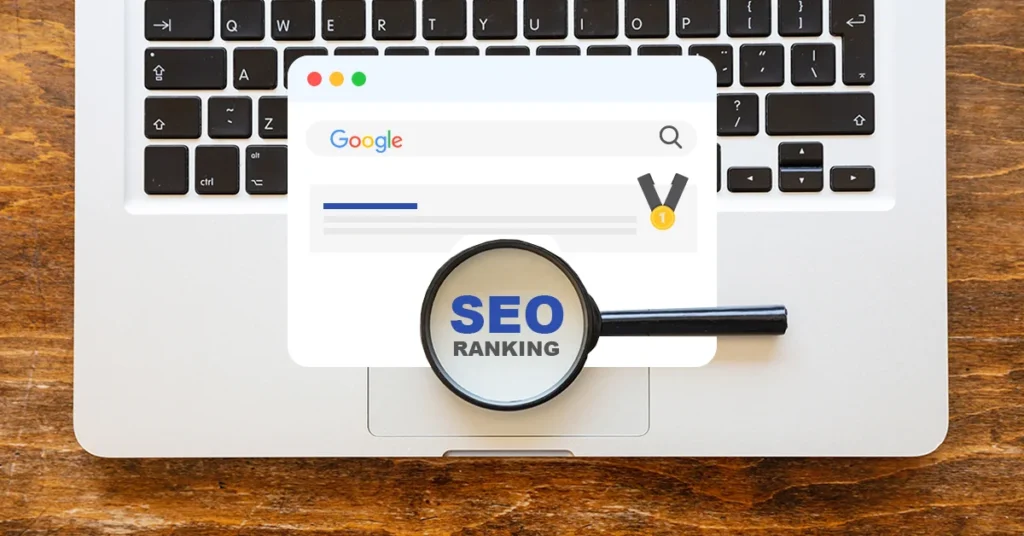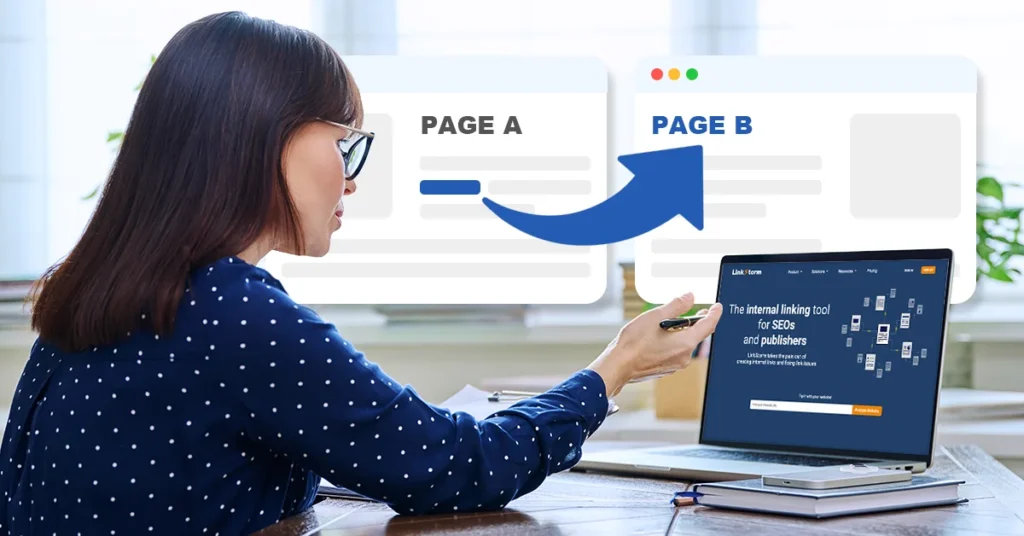
Understanding the Power of Internal Links
Internal links are a crucial component of a website’s design architecture and play a significant role in enhancing search engine optimization (SEO). By strategically placing internal links within the content, website owners can guide visitors to relevant information, improve user experience, and distribute ranking authority throughout the site. The importance of internal links is evident in their ability to shape the site’s architecture, prioritize important pages, and establish relationships between web pages.
Why Internal Links Matter for SEO
Internal links contribute to a website’s SEO by distributing page authority throughout the site. This means that when one page gains authority, it can pass that authority to other pages through internal linking. Properly implemented internal linking allows websites to account for two essential ranking factors: page authority and relevance. As a result, internal links help search engines understand which pages are important and relevant, ultimately contributing to improved search rankings.
Additionally, internal links provide website owners with complete control over how they link their content. Unlike backlinks, which are external links from other websites pointing to your content, internal links allow you to direct traffic within the same domain as your own website. This control enables you to link to the most valuable and relevant content for both your audience and search engines.
The Connection Between Internal Links and Website Usability
In addition to their impact on SEO, internal links also significantly enhance website usability. When used effectively, internal navigational links guide users through a seamless navigation experience by directing them to related or additional content of interest. Contextual links within the content not only provide users with access to more information but also assist search engines in understanding the relationships between different pieces of content on the site.
Furthermore, Google utilises internal links as part of its process for discovering and ranking pages. The structure of a website is established through these first few internal links and connections between pages, emphasising their importance in shaping user experience and influencing search engine rankings.

Mapping Out Your Site's Structure for SEO
Creating a Logical Site Hierarchy
When it comes to optimising a website for search engines, creating a logical site hierarchy is essential. A well-structured hierarchy not only enhances the user experience by making navigation intuitive but also plays a crucial role in improving SEO. By organising the content into categories and subcategories, website owners can ensure that both users and search engine crawlers can easily understand the relationship between different pages. Maintaining consistent page URLs is also important to preserve the integrity of internal links pointing to those pages.
One effective approach to establishing a logical site hierarchy is through the implementation of silo structures. Silos help group related content together, allowing for a clear thematic focus within each section of the website. This method aids in emphasising the relevance and authority of specific topics or keywords, contributing to improved ranking potential.
Tools to Visualise Your Site's Structure
Several tools are available to assist website owners in visualising and analysing their site’s structure for SEO optimization:
Interlinks Manager: This WordPress plugin offers detailed analysis of internal link structure and equity, providing interior link suggestions while editing articles. It also automates link generation from specific keywords and tracks clicks on internal links for in-depth analysis.
MOZ: Incorporates internal link analysis as part of its SEO toolkit for professionals.
PowerMapper: Excels at building sitemaps for existing websites and visualising website structure, SEO metrics, and analytics data on a visual sitemap.
When considering how many internal links to include, a reasonable approach involves adding around 2-5 links per post, especially in longer articles. Tools like ScreamingFrog can be used to analyze the site’s internal link structure effectively.
These tools provide valuable insights into how internal links are distributed across the site, identify areas for improvement, and offer suggestions to enhance the overall site structure.
In addition to these specialised tools, general-purpose SEO platforms like SEMrush offer detailed internal link audits that help spot issues and identify optimization opportunities. They also assist search engines in understanding the site’s structure more effectively.
By leveraging these tools, website owners can gain valuable insights into their site’s architecture and make informed decisions about optimising their internal linking strategy.
Anchor text plays a pivotal role in the effectiveness of internal linking strategies. It serves as the visible, clickable text in a hyperlink and provides valuable context to search engines about the web pages your links point to. By choosing the right anchor text and understanding its variations, website owners can significantly impact both user experience and SEO.

Choosing the Right Anchor Text
Selecting the appropriate anchor text is crucial for maximising the benefits of internal linking. When deciding on anchor text, it’s essential to consider using contextually-relevant terms that accurately describe the linked page. This descriptive anchor text not only enhances user experience by providing clear expectations but also signals to search engines the relevance of the linked content.
Moreover, anchor text should ideally incorporate an SEO keyword whenever possible. By aligning the anchor text with relevant keywords, website owners can further emphasise the topical relevance of the linked page, contributing to improved search engine rankings.
It’s important to note that over-optimizing anchor text, such as keyword stuffing, can have detrimental effects on a website’s SEO performance. Therefore, it’s crucial to ensure that anchor text looks natural and avoids repetitive use of keywords across different internal links.
Variations and Their Impact on SEO
Utilizing a mix of different anchor text types sounds much more natural and is beneficial for both user experience and SEO. By incorporating variations in anchor text, such as using synonyms or related phrases, website owners can create a diverse and organic linking profile.
Furthermore, employing contextually-relevant anchor text that properly describes the linked page presents an added opportunity to clearly communicate to search engines which keywords are relevant for ranking purposes. This approach helps boost relevance and reinforces the topical authority of specific pages within a website.
Anchors with varied wording also contribute to a more natural flow within content while maintaining a seamless user experience. This diversity not only aligns with best practices for internal linking but also mitigates potential risks associated with over-optimized or repetitive anchor texts.

How Internal Links Boost Your Search Engine Rankings
Internal links play a pivotal role in boosting search engine rankings and are instrumental in enhancing a website’s visibility and authority. By strategically incorporating internal links, website owners can effectively influence page authority and relevance, ultimately contributing to improved search rankings.
Internal Links and Page Authority
One of the key benefits of internal linking is its impact on page authority. When high-authority pages within a website link to other relevant pages, they pass on some of their authority to those linked pages, transferring part of their link value. This process helps distribute ranking power across the site, signalling to search engines the importance and relevance of specific content. As a result, pages receiving more internal links will tend to have higher visibility and are more likely to rank well in search engine results.
Furthermore, internal links contribute to clarifying which pages should be prioritised for ranking. By strategically linking essential pages within the site’s architecture, website owners can guide search engines towards understanding the most critical content. This focused approach aids in emphasising the topical relevance and significance of specific pages, thereby influencing their ranking potential.
The growth of website traffic by improving internal linking silo structure demonstrates the SEO benefits of internal linking strategies. Through this approach, websites have experienced significant improvements in user experience, increased user engagement, and enhanced page authority distribution.
Case Studies: Before and After Internal Linking
Case Study: Enhancing Website Traffic through Strategic Internal Linking
Prior to implementing an effective internal linking strategy, a website struggled with low visibility for several key landing pages.
By restructuring its internal link architecture and implementing contextual links within relevant content, the website saw a notable increase in organic traffic.
The improved internal linking strategy not only boosted page authority but also led to an increase in user engagement metrics such as time on site and page views per session.
As a result of these enhancements, the website experienced higher rankings for targeted keywords and topics.
This case study highlights how strategic internal linking positively impacted both SEO performance and user experience. The successful implementation of an optimised internal linking strategy resulted in tangible improvements in search engine rankings and overall website visibility.
In addition to passing power and relevance throughout the site, effective internal linking contributes to improving user experience by guiding visitors towards valuable content. Websites that strategically incorporate relevant internal links witness an increase in user’s time on site as visitors explore related or additional content facilitated by seamless navigation pathways.
By helping Google crawl and index pages more effectively while also improving overall website architecture, strategic internal linking directly influences website ranking outcomes.

Leveraging Internal Links for User Engagement
Internal links not only play a crucial role in enhancing SEO but also significantly contribute to improving user experience (UX). By strategically leveraging internal links, website owners can guide visitors to related content, improve site navigation, and ultimately enhance user engagement. The strategic placement of internal links within the content facilitates a seamless journey for users, leading them to discover additional valuable information and resources.
Enhancing User Experience Through Strategic Linking
The strategic use of internal links enhances user experience by providing visitors with a better sense of the website’s structure and facilitating easy navigation to related content.
Moreover, internal linking also improves a site’s user experience (UX) by helping visitors find related content. This means that when users are presented with internal links that lead them to additional relevant information, they are more likely to spend extended time on the website, exploring various interconnected topics. This not only enriches their overall experience but also increases the likelihood of returning to the site for future visits.
Strategic internal linking is an effective way to guide users through a curated journey across different sections of the website. By incorporating contextual links within the content, website owners can ensure that visitors have access to comprehensive information on specific topics or related subjects. This approach aligns with best practices for enhancing user engagement and encourages prolonged interaction with the site’s content.
Examples of Effective Internal Link Placement
An effective example of strategic internal link placement involves guiding users from an informative blog post towards relevant product or service pages. For instance, if a blog post discusses “10 Practical Steps to Master Stress Management,” strategically placed internal links can direct readers to specific products or services offered by the website that align with stress management techniques. This not only provides added value to the reader but also encourages exploration of other offerings available on the site.
Another example involves integrating internal links within product descriptions or informational articles. When discussing specific features or benefits of a product, including internal links that lead to complementary products or in-depth guides further enriches the user’s understanding and encourages them to explore additional offerings provided by the website.
By strategically placing internal links at key touch points throughout the content, websites can effectively guide users towards valuable resources while simultaneously increasing engagement and interaction with different sections of the site.

Internal Linking Best Practices from Top SEO Companies
When it comes to SEO, internal linking strategies are crucial for improving website visibility and enhancing user experience. These practices not only aid in discovering and indexing all pages but also play a significant role in boosting page authority and clarifying site structure. To gain a comprehensive understanding of effective internal linking strategies, it’s essential to consider insights from industry experts and adapt these strategies for different types of websites.
Insights from Industry Experts
According to Dr. Ivan Maximus, an experienced SEO consultant, “Internal linking is super critical to SEO and one of the biggest things you can do on a website to guide Google to your most important content.” This emphasises the pivotal role that internal linking plays in shaping a website’s search engine visibility and authority. By strategically incorporating internal links, website owners can effectively guide search engines towards prioritising essential content, ultimately influencing ranking outcomes.
Moreover, Sarah Kazumi, a renowned digital marketing strategist, highlights the significance of creating a clear structure and navigation flow through an internal linking strategy. She emphasises that this approach not only aids in improving search engine results but also contributes to enhancing user engagement metrics such as session duration. By providing users with seamless navigation pathways facilitated by strategic internal links, websites can effectively boost user interaction and overall browsing experience.
Adapting Strategies for Different Types of Websites
The implementation of internal linking best practices varies based on the nature of the website and its content. For e-commerce websites, integrating internal links within product descriptions or category pages is crucial for guiding potential customers towards relevant products or services. This strategic placement not only enriches the user’s understanding but also encourages exploration of additional offerings available on the site, ultimately contributing to improved conversion rates.
On the other hand, for informational websites or blogs, leveraging internal links within informative articles or blog posts is instrumental in guiding readers towards related content or resources. This approach enhances user engagement by providing visitors with access to comprehensive information on specific topics or related subjects while ensuring they have a seamless browsing experience.
Mueller, an expert at Google Webmasters, emphasises that adapting internal linking strategies based on the specific goals and content structure of each website is essential for maximising their impact on both SEO and user experience. He underscores that aligning internal link placement with the unique characteristics of different types of websites ensures that visitors are guided towards valuable content tailored to their interests and needs.

Analysing Your Internal Linking Strategy
After implementing an internal linking strategy, it is crucial for website owners to analyse its effectiveness and make necessary adjustments based on data-driven insights. This process involves utilising specific tools and metrics for evaluation, as well as adapting the internal linking strategy to optimise its impact on SEO and user experience.
Tools and Metrics for Evaluation
To assess the performance of an internal linking strategy, website owners can leverage a variety of tools and metrics that provide valuable insights into the effectiveness of their approach. These tools offer comprehensive analyses of internal link structures, page authority distribution, and overall site health.
One such tool is LinkStorm, which provides detailed analysis of internal link structure and its link equity. It offers interior link suggestions while editing articles, automates link generation from specific keywords, and tracks clicks on internal links for in-depth analysis. By utilising LinkStorm, website owners can gain valuable insights into how internal links are distributed across the site and identify areas for improvement.
Another powerful tool is InternalLinking, which excels at building sitemaps for existing websites and visualising website structure, SEO metrics, and analytics data on a visual sitemap. This tool provides a comprehensive overview of the site’s architecture, allowing website owners to identify potential optimization opportunities within their internal linking strategy.
In addition to these specialised tools, general-purpose SEO platforms like Ahrefs offer detailed internal link audits that help spot issues and identify optimization opportunities. These audits provide valuable insights into how internal links are distributed across the site, offering suggestions to enhance the overall site structure.
Furthermore, Semrush incorporates internal link analysis as part of its SEO toolkit for professionals. It offers in-depth evaluations of internal link distribution and provides actionable recommendations to improve the effectiveness of an internal linking strategy.
When evaluating an internal linking strategy, it’s essential to consider key metrics such as page authority distribution, click-through rates on internal links, and overall user engagement metrics. By analysing these metrics, website owners can gain a comprehensive understanding of how their internal linking strategy is influencing search engine rankings and user experience.
Adjusting Your Strategy Based on Data
Based on the insights gathered from these tools and metrics, website owners can make informed decisions about adjusting their internal linking strategy to maximise its impact. This may involve reevaluating the placement of internal links within content, optimising anchor text variations, or restructuring the site’s hierarchy to enhance navigation pathways.
For instance:
If analysis reveals that certain pages have low click-through rates on their internal links or limited page authority distribution, website owners can consider revising the placement or context of these links within the content.
In cases where specific anchor text variations are underperforming in terms of driving traffic or conveying relevance to search engines, adjustments can be made to align with more effective keyword strategies.
Additionally:
If certain sections of the site exhibit suboptimal thematic focus or lack clear hierarchical organisation,
Website owners may consider restructuring content categories using silo structures or implementing additional contextual links within related content.
By continuously monitoring key performance indicators (KPIs) related to internal links, such as click-through rates and page authority distribution patterns, website owners can iteratively refine their internal linking strategies based on real-time data, ultimately enhancing both SEO performance and user experience across their websites.

The Impact of Internal Links on Website Ranking
Internal links play a pivotal role in influencing a website’s ranking on search engine results pages (SERPs). By strategically incorporating internal links, website owners can significantly impact the site’s visibility, authority, and overall success. Real-world examples and case studies demonstrate the tangible improvements in SEO score, Google rankings, and user traffic resulting from effective internal linking strategies.
Real-World Examples of Ranking Improvements
Case Study: Growth of Website Traffic by Improving Internal Linking Silo Structure
Prior to optimising its internal linking strategy, a website experienced limited visibility and struggled to rank for targeted keywords.
Through the implementation of an improved internal linking silo structure, the website witnessed significant improvements in SEO score, Google rankings, and user traffic.
The strategic placement of internal links not only boosted page authority but also clarified the site’s structure, leading to enhanced crawlability for search engines.
As a result of these enhancements, the website experienced higher rankings for targeted keywords and topics, ultimately driving increased organic traffic and user engagement.
This case study highlights how a well-executed internal linking strategy positively impacted both SEO performance and overall website ranking. The successful optimization of internal link structures resulted in notable improvements in search engine visibility and authority.
Furthermore, enterprise brands have showcased the power of internal linking in significantly impacting their site’s visibility and authority. These case studies emphasise how strategic internal linking contributes to improved crawlability for search engines while enhancing user experience. By guiding visitors to relevant information through contextual links within content, these brands have successfully elevated their search rankings and overall site success.
The Long-Term Benefits of a Solid Internal Linking Structure
The long-term benefits of establishing a solid internal linking strategy structure extend beyond immediate ranking improvements. A well-crafted internal linking strategy contributes to sustained growth in website ranking, authority distribution, and user engagement over time.
By consistently guiding users towards valuable content through strategic internal links, websites foster prolonged interaction with their offerings, leading to increased session duration, page views per session, and ultimately contributing to higher conversion rates.
Moreover, a robust internal linking framework aids in establishing clear thematic focus within different sections of the website, emphasising relevance and topical authority for specific topics or keywords, which translates into sustained visibility on SERPs over time.
Additionally, the continuous improvement of page authority distribution through effective internal linking directly influences long-term ranking potential, as high-authority pages pass on their influence to linked pages throughout the site, signalling their importance to search engines over an extended period.

Internal Links and Google SEO: Insights and Tips
Internal links play a crucial role in the context of Google’s Search Engine Optimization (SEO) guidelines. Understanding Google’s perspective on internal linking and aligning with its SEO principles is essential for website owners aiming to enhance their search rankings and visibility.
Google's View on Internal Linking
Google’s official Search Engine Optimization (SEO) Starter Guide discusses the significance of internal linking, beginning with the use of breadcrumbs. According to the guide, internal linking is an essential factor for Google and other search engines. Google follows links to discover content on websites and to rank this content in the search results. If a post or page receives many links, this signals to Google that it’s an essential or high-value article. This applies to both broken internal links and external links.
Moreover, Google will also use internal links to find pages and pass the link juice to whatever pages those links point to. Since Google follows links to crawl a web page, it will use your internal linking structure to identify new pages of yours to crawl. It will also use those links to learn more about the structure and hierarchy of your site, as well as the relationship between your different pages.
When you use internal links strategically, you signal that page A is related to page B. This helps Google understand the context of broken links on your pages and how different pages relate to each other.
Tips for Aligning with Google's SEO Guidelines
Aligning with Google’s SEO guidelines involves strategic implementation of internal linking practices that resonate with its crawling and ranking algorithms:
Strategic Link Placement: Strategically place internal links within content to signal relevance between related pages. By guiding users through contextual links, website owners can effectively communicate the relationships between different pieces of content on their site.
Hierarchy Clarification: Use internal linking structures to clarify the hierarchy of your website’s content. By creating clear thematic focus within each section through silo structures, website owners can emphasise relevance and authority for specific topics or keywords.
Contextual Relevance: Ensure that anchor text used in internal links is contextually relevant and accurately describes the linked page. Aligning anchor text with relevant keywords further emphasises topical relevance, contributing to improved search engine rankings.
User Experience Enhancement: Leverage internal linking strategies not only for SEO but also for enhancing user experience by providing seamless navigation pathways facilitated by strategic internal links.
Continuous Monitoring: Regularly analyse key metrics such as click-through rates on internal links and page authority distribution patterns using tools like LinkStorm or InternalLinking. Based on data-driven insights, make informed decisions about adjusting the internal linking strategy for optimal impact on both SEO performance and user experience.
By aligning with these tips based on insights from industry experts and understanding Google’s view on internal linking, website owners can effectively optimise their sites according to Google’s SEO guidelines while enhancing user engagement metrics such as session duration.

Crafting a Winning Internal Linking Strategy
Crafting an effective internal linking strategy is essential for both SEO and user experience. It involves connecting different pages within a website using hyperlinks and creating a clear structure and navigation flow add internal links. This benefits websites in several ways, including discovering and indexing all pages, boosting page authority, clarifying site structure, and helping users navigate to relevant pages.
Step-by-Step Guide to Developing Your Plan
Developing a winning internal linking strategy requires careful planning and execution. Here’s a step-by-step guide to help website owners craft an effective plan:
Identify Key Pages: Begin by identifying the key pages on your website that you want to prioritise for ranking and visibility. These may include cornerstone content, landing pages, or important category pages.
Establish Thematic Relevance: Group related content together based on thematic relevance. This can be achieved through the implementation of silo structures, which help create a clear thematic focus within each section of the website.
Keyword Alignment: Align internal links with relevant keywords to emphasise topical relevance and enhance search engine rankings. By strategically incorporating keywords into anchor text, website owners can effectively communicate the context of linked pages to both users and search engines.
Contextual Link Placement: Strategically place internal links within content to signal relevance between related pages. By guiding users through contextual links, website owners can effectively communicate the relationships between different pieces of content on their site.
Continuous Monitoring: Regularly analyse key metrics such as click-through rates on internal links and page authority distribution patterns using tools like LinkStorm or InternalLinking. Based on data-driven insights, make informed decisions about adjusting the internal linking strategy for optimal impact on both SEO performance and user experience.
By following these steps, website owners can develop a comprehensive internal linking strategy that aligns with their SEO goals while enhancing user engagement metrics such as session duration and page views per session.
Incorporating Feedback and Continuous Improvement
Incorporating feedback from analytics data and continuous improvement are vital aspects of maintaining an effective internal linking strategy over time.
Leveraging Analytics Data
Analysing analytics data provides valuable insights into how users interact with internal pages and links across the site. By monitoring metrics such as click-through rates, time spent on linked pages, and user navigation pathways facilitated by internal links, website owners can gain a deeper understanding of how their internal linking strategy influences user behaviour.
Iterative Refinement
Based on insights gathered from analytics data, website owners should iteratively refine their internal linking strategies, continuously optimising link placement, anchor text variations, and overall site hierarchy to enhance user experience while maximising SEO impact.
This iterative refinement process ensures that the internal linking strategy remains aligned with evolving user preferences, search engine algorithms, and industry best practices, ultimately contributing to sustained improvements in both SEO performance and user engagement across the website.
By incorporating feedback from analytics data into the decision-making process, website owners can make informed adjustments to their internal linking strategies based on real-time user behaviour patterns, ensuring that their approach remains responsive to changing dynamics within their target audience and search engine ranking algorithms.

Common Mistakes to Avoid in Internal Linking
When it comes to internal linking, web owners must be cautious about common mistakes that can hinder their SEO efforts and user experience. Understanding these pitfalls is crucial for crafting an effective internal linking strategy that aligns with best practices and search engine guidelines.
Over-Linking and Its Consequences
One prevalent mistake in internal linking is over-linking, which occurs when a website contains an excessive number of internal links, often leading to pages being interconnected in a convoluted manner. This practice can have detrimental effects on both SEO performance and user experience.
Unnecessary links could actually hurt your SEO, especially if Google perceives them as spammy. When there are too many internal links present within the content, it dilutes the PageRank for each link and ultimately impacts the website’s ranking. Too many internal links not only diminish the authority passed on to each linked page but also make it challenging for users (and search engines) to identify which links within same page are important. As a result, this can lead to decreased visibility and crawlability for essential content on the site.
Moreover, hundreds or thousands of links on a page make it hard for users (and search engines) to identify which links are important. This can significantly impact user experience by overwhelming visitors with an abundance of navigational options, potentially leading to confusion and frustration.
Neglecting Link Quality and Relevance
Another critical mistake in internal linking is neglecting link quality and relevance. Good internal links are crucial to your SEO, as they help distribute page authority throughout your site, improving crawlability for search engines and enhancing the user experience by providing relevant additional content. However, if web owners fail to consider the quality and relevance of their internal links, it can lead to suboptimal outcomes.
Although SEOs understand the value of interlinking, many put little thought into what content they reference together nofollow links and how. The purpose of internal links is to direct users towards another page of the same website; however, some web owners make mistakes when it comes to these redirecting links. Internal linking is one of the most important factors of on-page SEO but is often overlooked.
Internal linking only affects SEO by encouraging engagement; time on site, time per page, pages per visit, etc., emphasising its role in influencing user behaviour metrics. Therefore, neglecting link quality and relevance can hinder user engagement metrics such as session duration and pages per visit.

How SEO Services Utilise Internal Links
SEO services play a pivotal role in leveraging internal links to enhance website visibility, authority, and overall success. By strategically incorporating internal links into a broader SEO strategy, these services showcase the power of internal linking through case studies from successful campaigns and demonstrate the significant impact on website traffic.
Case Studies from Successful Campaigns
Case Study: Growth of Website Traffic by Improving Internal Linking Silo Structure
One compelling example of successful internal linking strategies involves the growth of website traffic through the improvement of internal linking silo structure. Prior to optimising its internal linking strategy, a website experienced limited visibility and struggled to rank for targeted keywords. However, by implementing an improved internal linking silo structure, the website witnessed significant improvements in SEO score, Google rankings, and user traffic.
The strategic placement of internal links not only boosted page authority but also clarified the site’s structure, leading to enhanced crawlability for search engines. As a result of these enhancements, the website experienced higher rankings for targeted keywords and topics, ultimately driving increased organic traffic and user engagement.
This case study exemplifies how effective internal linking strategies directly contribute to improved search engine visibility and authority. The successful optimization of internal link structures resulted in notable improvements in search engine rankings and overall website performance.
Case Study: Case Studies from Our Clients
Furthermore, enterprise brands have showcased the power of internal linking in significantly impacting their site’s visibility and authority. These case studies emphasise how strategic internal linking contributes to improved crawlability for search engines while enhancing user experience. By guiding visitors to relevant information through contextual links within content, these brands have successfully elevated their search rankings and overall site success.
These case studies highlight how effective internal linking strategies positively impact both SEO performance and user experience. The successful implementation of optimised internal linking strategies resulted in tangible improvements in search engine rankings and overall website visibility.
Integrating Internal Links into a Broader SEO Strategy
Integrating internal links into a broader SEO strategy is essential for maximising their impact on both SEO performance and user experience. SEO services utilise various techniques to seamlessly integrate internal links into an overarching optimization approach:
Strategic Link Placement: SEO services strategically place internal links within content to signal relevance between related pages. By guiding users through contextual links, these services effectively communicate the relationships between different pieces of content on websites.
Hierarchy Clarification: Through silo structures and clear thematic focus within each section of websites, SEO services emphasise relevance and authority for specific topics or keywords. This approach aids in improving crawlability for search engines while enhancing user experience by providing relevant additional content.
Contextual Relevance: SEO services ensure that anchor text used in internal links is contextually relevant and accurately describes the linked page. Aligning anchor text with relevant keywords further emphasises topical relevance, contributing to improved search engine rankings.
User Experience Enhancement: Leveraging internal linking strategies not only for SEO but also for enhancing user experience by providing seamless navigation pathways facilitated by strategic internal links is a key focus area for SEO services.
By integrating these practices into a broader SEO strategy, SEO services effectively optimise websites according to Google’s guidelines, while enhancing user engagement metrics such as session duration, and ultimately driving increased organic traffic and conversions across websites.

Enhancing Website Navigation with Internal Links
Internal links play a crucial role in shaping the site’s architecture, establishing relationships between pages, and distributing ranking authority throughout the site. By adding internal links and strategically placing them within content, you can guide visitors to relevant information, improve user experience, and enhance search engine optimization efforts.
Improving Site Architecture for Better User Experience
A well-structured internal linking strategy not only aids in search engine optimization but also significantly enhances the overall user experience. When users are presented with internal links that lead them to additional relevant information, they are more likely to spend extended time on the website, exploring various interconnected topics. This not only enriches their overall experience but also increases the likelihood of returning to the site for future visits.
Moreover, internal links give users a better sense of your site structure and make it easier for them to navigate to related content. This approach ensures that users can seamlessly explore relevant topics or other pages on your site, without encountering navigational barriers, thereby creating a more engaging and satisfying browsing experience.
Strategic internal linking is an effective way to guide users through a curated journey across different sections of the website. By incorporating contextual links within the content, website owners can ensure that visitors have access to comprehensive information on specific topics or related subjects. This approach aligns with best practices for enhancing user engagement and encourages prolonged interaction with the site’s content.
Navigation Links vs. Contextual Links
When it comes to enhancing website navigation through internal links, two primary types of internal links important play distinct roles: navigation links and contextual links.
Navigation Links
Navigation links are typically found in menus, sidebars, footers, or other persistent elements of a website’s layout. These links serve as primary pathways for users to navigate between different sections or pages of a website. While navigation links are essential for providing users with an overview of available content and facilitating direct access to key areas authoritative pages of the site, they may not always offer detailed context about specific topics or related content.
Contextual Links
On the other hand, contextual links are embedded within the body of content itself and provide direct access to related or additional information within the context of a specific topic or subject matter. These links offer in-depth exploration opportunities for users by guiding them towards relevant resources while they engage with specific pieces of content. Contextual links contribute significantly to improving user engagement metrics such as session duration and pages per visit by facilitating seamless transitions between interconnected topics.
Incorporating both navigation links and contextual links into an internal linking strategy is essential for providing users with comprehensive navigation pathways while ensuring easy access to detailed information within specific contexts.
By leveraging both types of internal linking effectively, website owners can create a cohesive navigation experience that guides users through broader sections of the site via navigation links, while also offering detailed insights into specific topics through contextual links, ultimately enhancing both SEO performance and user engagement across their websites.

Measuring the Success of Your Internal Linking Efforts
After implementing an internal linking strategy, it is essential to measure its impact and make informed decisions based on data-driven insights. By using internal link audit, tracking key performance indicators (KPIs) and interpreting the resulting data, website owners can gain valuable insights into the effectiveness of their internal linking efforts.
Key Performance Indicators (KPIs) to Track
When evaluating the success of an internal linking strategy, several key performance indicators (KPIs) should be tracked to assess its impact on search engine rankings and user experience. These KPIs provide valuable insights into how internal links are influencing various aspects of website performance:
Page Authority Distribution: Tracking the distribution of page authority across different sections of the website provides insights into how effectively internal links are passing power and relevance throughout the site. By monitoring changes in page authority distribution patterns, website owners can gauge the impact of their internal linking strategy on improving ranking potential for specific pages.
Click-Through Rates on Internal Links: Analysing click-through rates on internal links helps evaluate how effectively users are navigating through interconnected content. Higher click-through rates indicate that users are engaging with internal links and exploring related topics or pages, contributing to improved user experience metrics such as session duration and pages per visit.
User Engagement Metrics: Monitoring user engagement metrics such as time spent on linked pages, bounce rates, and pages per visit provides insights into how internal links are influencing user behaviour. By analysing these metrics, website owners can assess whether their internal linking strategy is effectively guiding visitors towards valuable content while encouraging prolonged interaction with the site’s offerings.
Crawlability and Indexing: Assessing how search engines crawl and index linked pages provides valuable insights into how well internal links facilitate discoverability for new content. By tracking indexing rates for linked pages, website owners can ensure that their internal linking strategy aligns with search engine algorithms’ crawling behaviours.
Improvements in Website Architecture: Evaluating improvements in website architecture resulting from an optimised internal linking strategy involves assessing factors such as thematic relevance within different sections, hierarchical organisation, and overall clarity in site structure. These architectural improvements contribute to enhanced crawlability for search engines while providing a more intuitive navigation experience for users.
By tracking these KPIs, website owners can gain comprehensive insights into how their internal linking efforts are influencing both SEO performance and user experience across their websites, ultimately enabling them to make informed decisions about refining their approach based on real-time data-driven insights.
Interpreting Data and Making Informed Decisions
Interpreting the data gathered from tracking KPIs is crucial for making informed decisions about adjusting an internal linking strategy to optimise its impact on both SEO performance and user experience.
When analysing page authority distribution patterns, website owners should look for shifts in authority towards essential landing pages or category pages, as this indicates that internal links are effectively passing power throughout the site, contributing to improved ranking potential for specific content areas.
Moreover, higher click-through rates on internal links signify effective navigation pathways facilitated by strategic link placement within content, leading to increased engagement with related topics or pages and ultimately enhancing user experience metrics such as session duration and pages per visit.
By interpreting these trends, website owners can identify areas where adjustments may be needed within their internal linking strategy to further enhance its impact on both SEO performance and overall user engagement across their websites.
In addition, analysing improvements in website architecture resulting from an optimised internal linking strategy involves assessing factors such as thematic relevance within different sections, hierarchical organisation, and overall clarity in site structure; these architectural enhancements contribute to enhanced crawlability for search engines while providing a more intuitive navigation experience for users.
Based on these interpretations, website owners can iteratively refine their internal linking strategies based on real-time data-driven insights, ultimately enhancing both SEO performance and user experience across their websites over time.




